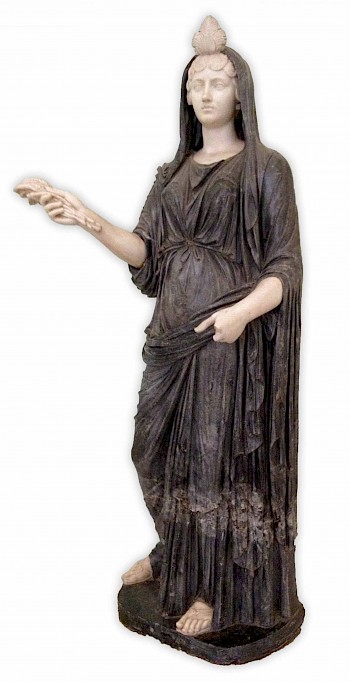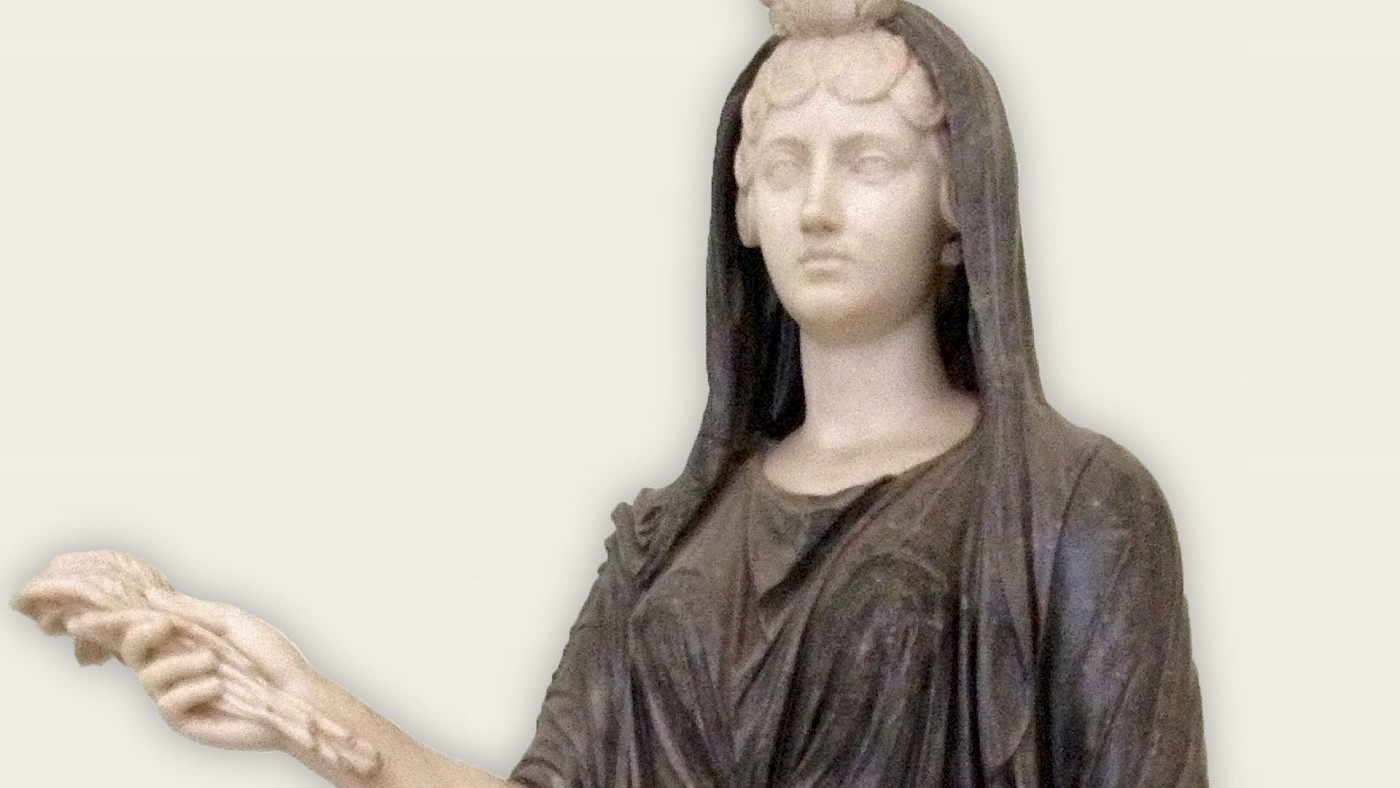The Archaeological Museum of Naples has an impressive collection of Roman statues. One of them, with inventory number 6368 and dated to the second century AD, has the following description: “Fortuna-Isis restored as the younger Faustina in the clothes of Ceres.”
The museum’s description is almost perfect in how it describes the object without actually explaining anything about it. Who’s Fortuna-Isis? Who was Faustina the Younger? Why would this statue be “restored” from one goddess to resemble a historical figure dressed up to look like another deity? The description isn’t bad or necessarily wrong, but it’s frustratingly obtuse.
A closer look
So let’s try to unpack this statue. We’ll go over the different elements and see what might be going on here. I don’t want to claim that this article offers the definitive interpretation of this statue, but we should be able to untangle the description and gain a better understanding of what this statue is. First, though, let’s start by showing the complete statue, which if I remember correctly was more than life-size.

Let’s start with Fortuna-Isis. Fortuna was a Roman goddess, the embodiment of fortune and good luck. She’s the Roman counterpart to the Greek goddess Tyche. Tyche had become popular in the art of the Hellenistic period (roughly, the last three centuries BC), where she was often depicted wearing a crown that resembled the circuit walls of a city. She was often specifically associated with particular cities, like the Tyche of Antioch, a statue currently in the Vatican Museums.
Isis is an Egyptian deity. When Egypt became part of the Graeco-Roman world, Isis was readily adopted by the Greeks and Romans and her cult spread through the Mediterranean world. She was thought to exert power over fate, which made her more or less analogous to Fortuna/Tyche, the Greek and Roman personifications of fortune. One of Isis’ characteristic attributes in art is the headdress that this statue is adorned with.
So that explains the Fortuna-Isis bit of the description. The statue depicts the Graeco-Roman goddess of fortune with a headdress typical of depictions of the Egyptian goddess Isis. But what about the association with another deity, Ceres? Ceres is the Roman counterpart of the Greek Demeter, the goddess of agriculture and fertility. The statue holds sheaves of wheat in her right hand, the attributes of this particular goddess.
According to Herodotus, “Isis in the Greek language is Demeter” (Hdt. 2.29.2). This isn’t completely surprising: as the goddess of fertility and agriculture, Demeter, too, was essentially a deity of good fortune. In short, then, the statue combines characteristics of two or three deities (depending on whether or not we want to “untangle” Fortuna/Tyche and Isis) associated with (good) fortune. Overkill, perhaps, but a good message cannot be conveyed often enough, I suppose.
Faustina the Younger
So where does Faustina come into this, and why is the statue described as “restored”? Often, the Romans re-appropriated statues by removing the head and carving a new one to take its place. In this way, statues could be dedicated anew to particular divine or mortal figures without going through the expense of making a statue completely from scratch. Perhaps something similar happened here. Indeed, Roman sculptors are known to have made statues with sockets between the shoulders to fit any type of head that the client might wish; one could mix and match bodies and heads this way.
So it seems likely, if the museum’s description is accurate, that the statue originally represented a goddess and was later fitted with a portrait of Faustina. As you may have noticed, the statue is made of two different types of marble, so it would have been fairly simple to swap the head or even the lower arms, if necessary. It does look rather complicated to fit a different head considering the veil, but who knows? For now, this is as good a theory as any. (It’s also possible that the statue was restored in modern times, but that begs the question why it would have been restored to resemble Faustina? Only the museum can provide the definitive answer, I expect.)

What surprises me more is that the museum writes that this statue represents Faustina the Younger, the wife of the emperor Marcus Aurelius (r. AD 161-180). Her mother, Faustina the Elder, is more commonly associated with Ceres: coins dedicated to her feature Faustina’s portrait on one side and Ceres on the other, and she had a temple where both her and Ceres were worshipped.
Unlike the Greeks, the Romans tended to idealize their portraits less, striving for greater realism. It’s not perfect, of course; sometimes, portraits are clearly idealized to a greater or lesser extent. Julius Caesar, for example, supposedly insisted he was represented as less follicly challenged than he really was. But for the most part, portraits of historical Romans tend to give at least a decent idea of what they may have really looked like. And the face of this woman does resemble Faustina the Younger more than her mother, so one assumes the museum is correct.
Mortals as divinities
Why would members of the imperial family be depicted as deities? Well, it’s complicated. As I wrote in my article on the Augustus of Prima Porta, Augustus was careful to downplay any links to the immortal realm, despite the fact that his adoptive father, Julius Caesar, was deified after death and he was, by extension, of divine blood. And the Julii themselves, of which Augustus was a member, traced their ancestry back to Aeneas, who was himself a demigod, the son of the goddess Aphrodite.
Fast-forward a century and a half and the imperial family has decreasingly fewer and fewer inhibitions when it comes to emphasizing their links to the divine realm. After all, emperors have been deifying their (deceased) predecessors for generations, so why would they not regard themselves as living gods? And if the emperors are gods, then surely their wives and children must also be divine?
Still, some restraint remains in place. At least nominally, the emperor of the second century AD is only the primus inter pares, as Augustus had put it: “the first among equals”. It wouldn’t be until Diocletian (r. AD 284-305) that an emperor would outright proclaim himself to be dominus et deus, that is “lord” (especially in the sense of “master of slaves”) and “god”. But by then, the Classical period has effectively come to an end.
